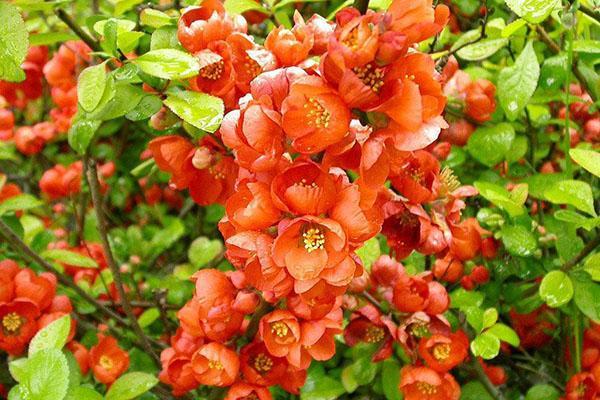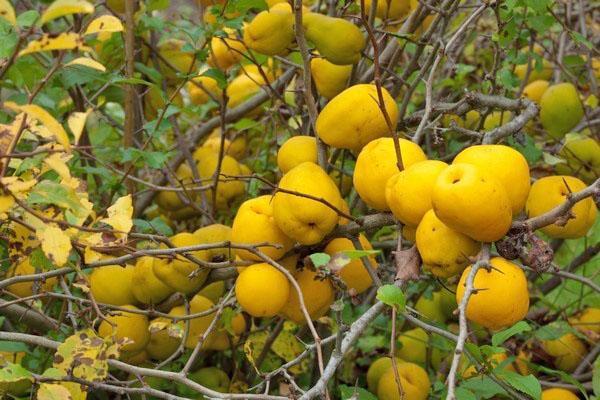How Japanese quince can be useful and harmful to human health
 Japanese quince is well known to gardeners as an ornamental shrub, strewn with rare beauty red-pink inflorescences in spring. But not everyone knows what benefits and harms the fruits of Japanese quince bring. Meanwhile, harvesting and consuming quince correctly, you can get rid of many diseases and keep your health in good shape. Let's find out more about her.
Japanese quince is well known to gardeners as an ornamental shrub, strewn with rare beauty red-pink inflorescences in spring. But not everyone knows what benefits and harms the fruits of Japanese quince bring. Meanwhile, harvesting and consuming quince correctly, you can get rid of many diseases and keep your health in good shape. Let's find out more about her.
Read also the article: quince jam recipe!
General information about Japanese quince

In addition to the fruits of the Japanese quince, its leaves are used in folk medicine, which are collected and dried.
What are the beneficial properties of quince
 Chaenomeles fruits are rich in vitamins and other beneficial organic compounds. Ripe fruits contain about 12% sugars, among which there are fructose, glucose and sucrose. In addition, they contain many organic acids that are of great benefit. Among them:
Chaenomeles fruits are rich in vitamins and other beneficial organic compounds. Ripe fruits contain about 12% sugars, among which there are fructose, glucose and sucrose. In addition, they contain many organic acids that are of great benefit. Among them:
- apple,
- wine,
- ascorbic,
- fumaric,
- lemon,
- chlorogenic.
These compounds normalize the acid-base balance, are involved in carbohydrate and fat metabolism, prevent the development of nervous and muscle pathologies and such severe ailments as Alzheimer's and Parkinson's.
Why quince is useful - high content of ascorbic acid. Therefore, it is often called the northern lemon. This acid gives the ripe fruit a strong sour taste.
 In addition to vitamin C, quince fruits contain carotene, vitamins E, PP, B1, B2, B6. Of the trace elements found in them:
In addition to vitamin C, quince fruits contain carotene, vitamins E, PP, B1, B2, B6. Of the trace elements found in them:
- iron,
- copper,
- manganese,
- boron,
- cobalt and others.
Also in the fruits of quince found such useful substances as anthocyanins, tannins, flavonoids and fatty acids. All of the listed compounds of Japanese quince have their own beneficial properties and contraindications. When eating fruits, they must be taken into account.
Fruit Japanese quince have anti-inflammatory, tonic and diuretic effects on the body. Regular consumption of them in food can increase immunity and significantly reduce the body's susceptibility to the most common colds.
What else is quince useful for the body - its properties normalize the activity of the nervous and muscular systems, improve metabolic processes, cleanse the walls of blood vessels from cholesterol plaques.
The high content of iron and vitamin C can effectively treat and prevent anemia and wasting. Quince fruits act as a fixative and antiemetic agent. They are also known for their haemostatic and antioxidant properties. Quince is useful as a choleretic and diuretic for diseases of the gallbladder and urinary system.
Quince seeds in the form of water decoctions are popular in folk medicine as enveloping, mild laxatives, and cough-relieving drugs.
The pulp of the fruit effectively removes excess fluid in case of edema that accompanies renal and heart failure. Regular consumption of quince can improve the functioning of the gastrointestinal tract.
Japanese quince in cooking
 Many people do not like quince because of its pronounced sour taste. In addition, its fruits are quite hard. How is quince eaten to avoid these disadvantages? Fruits are stored for a long time and become softer and more aromatic by spring. They are also used in the form of compotes, jelly, jam... After adding sugar and cooking, the fruit becomes softer and does not sour. Short heating during the cooking process practically does not destroy the nutrients contained in it. The high content of pectin allows you to obtain jelly and marmalades of excellent taste without long boiling. Due to the high acid content, the workpieces are stored for a long time.
Many people do not like quince because of its pronounced sour taste. In addition, its fruits are quite hard. How is quince eaten to avoid these disadvantages? Fruits are stored for a long time and become softer and more aromatic by spring. They are also used in the form of compotes, jelly, jam... After adding sugar and cooking, the fruit becomes softer and does not sour. Short heating during the cooking process practically does not destroy the nutrients contained in it. The high content of pectin allows you to obtain jelly and marmalades of excellent taste without long boiling. Due to the high acid content, the workpieces are stored for a long time.
 Chaenomeles fruits are dried and then used in compotes along with other dried fruits.
Chaenomeles fruits are dried and then used in compotes along with other dried fruits.
In the cooking of Central Asia and the Caucasus, recipes for cooking meat with the addition of quince are popular. Dishes acquire juiciness, unusual aroma and are better digested.
The use of Japanese quince in cosmetology
 Cosmetologists are well aware of the beneficial properties of quince leaves and seeds. They do not bring harm to health, since they are used only externally. The leaf extract has a moisturizing, anti-inflammatory and softening effect. Benefits decoction of leaves and fruits for the treatment of seborrhea, dandruff and increased hair breakage. Preparations based on chaenomeles extracts are used for excessive oily skin and hair.
Cosmetologists are well aware of the beneficial properties of quince leaves and seeds. They do not bring harm to health, since they are used only externally. The leaf extract has a moisturizing, anti-inflammatory and softening effect. Benefits decoction of leaves and fruits for the treatment of seborrhea, dandruff and increased hair breakage. Preparations based on chaenomeles extracts are used for excessive oily skin and hair.
Water decoction of seeds is effective as a lotion against fatigue and discomfort in the eyes. With cotton swabs dipped in broth, wipe problem skin. Derivatives from the seeds are found in masks and skin care lotions.
In what cases is the use of quince contraindicated
In addition to the obvious benefits, the use of Japanese quince can be harmful. To avoid it, you need to be aware of the contraindications. Thus, a high content of active biological substances can cause allergic reactions. Therefore, it is undesirable to eat a large number of fruits at once.
Also contraindications are constipation, stomach ulcers, inflammatory processes in the small and large intestines, a tendency to allergies, pleurisy. After eating the fruit, it is advisable to immediately rinse the mouth with water with the addition of baking soda in order to neutralize the effect of acids that corrode tooth enamel.
Before eating quince fruits, it is necessary to remove the seeds along with the seed pods, as they are toxic. It should also be borne in mind that the fluff covering the surface of the fruit can irritate the larynx and vocal cords.
How to prepare and use vodka tincture
 To prepare tincture of Japanese quince on vodka, take the most ripe and aromatic fruits. They are washed, seeds removed and crushed. The resulting mass is placed in a jar and poured with vodka so that it completely covers the fruit mass. The resulting mixture is tightly covered with a lid and left in a dark place for three weeks. Then sugar is added to it and the jar is left for another week, shaking from time to time so that the sugar dissolves. After a week, filter the tincture and add a little vanillin if desired. The tincture is bottled. It is better to store it in a cool dark place.
To prepare tincture of Japanese quince on vodka, take the most ripe and aromatic fruits. They are washed, seeds removed and crushed. The resulting mass is placed in a jar and poured with vodka so that it completely covers the fruit mass. The resulting mixture is tightly covered with a lid and left in a dark place for three weeks. Then sugar is added to it and the jar is left for another week, shaking from time to time so that the sugar dissolves. After a week, filter the tincture and add a little vanillin if desired. The tincture is bottled. It is better to store it in a cool dark place.
For 500 g of quince fruits, take 800 ml of vodka and 150 g of sugar.
As we can see, the benefits of Japanese quince are undeniable, and the possible harm can be minimized by competent use.